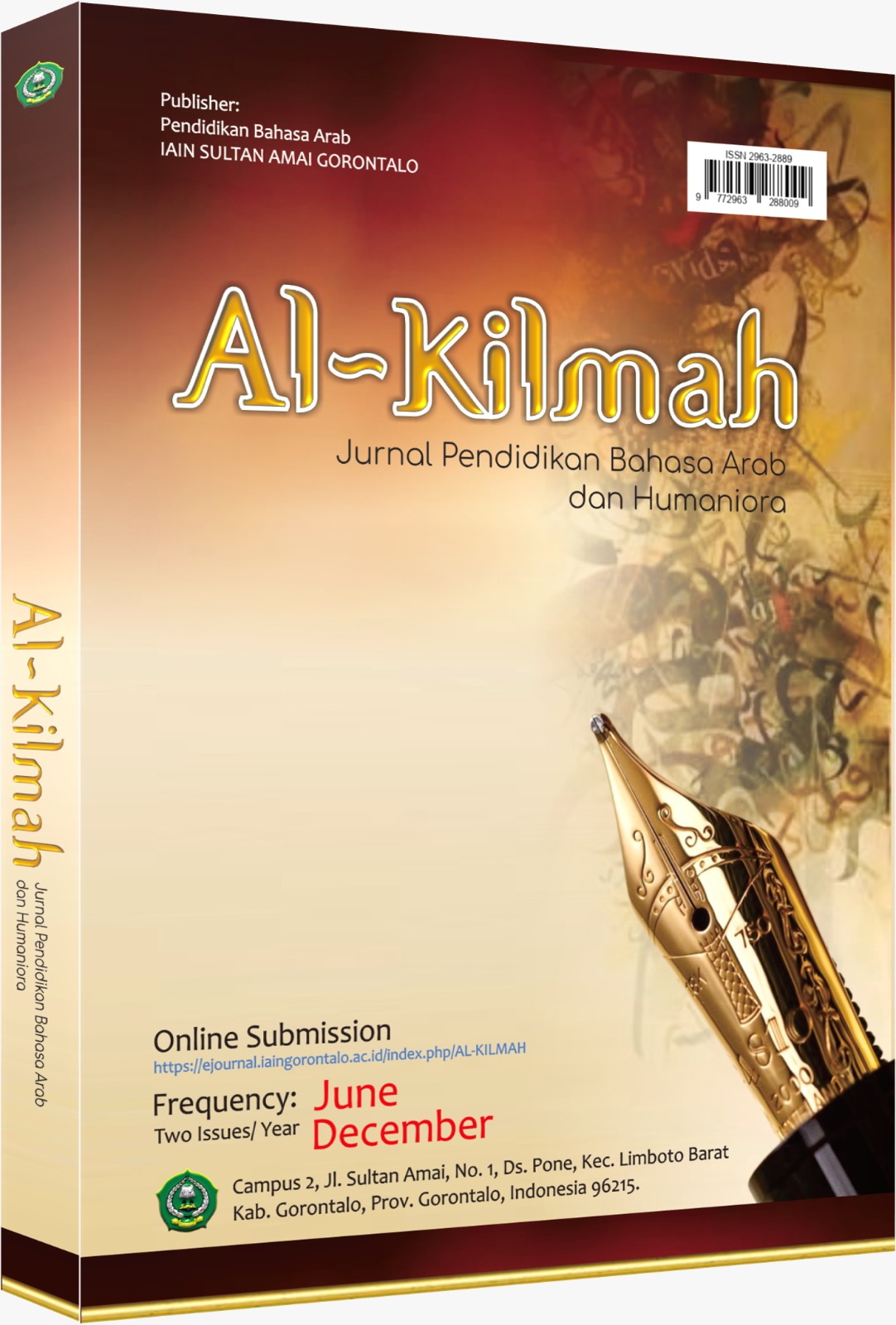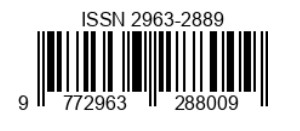Analysis of Phonological Errors in Arabic Reading Skills of Grade VII Students of MTs Darul A'mal Metro
DOI:
https://doi.org/10.58194/alkilmah.v4i1.2316Keywords:
Phonology Errors, Reading Skills, Arabic LearnerAbstract
This study aims to analyze phonological errors in the reading skills of Arabic texts by grade VII students. Data sources were obtained from interviews with teachers and students, as well as recording the process of reading Arabic texts by students. The data was then analyzed through the identification and classification of phonological errors that occurred. This study identified various phonological pronunciation errors in students' Arabic reading skills, including the change of the phoneme ع to ء, such as in the pronounced بائع pronunciation, the change of the phoneme خ to ح such as أختي to أحتي, and the change of the phoneme ق to ك, e.g. the word سائق becomes سائك. This phonological error is caused by the limited knowledge of students in distinguishing phonemes that have adjacent articulations, as well as the lack of adequate reading practice, which results in inaccuracies in the pronunciation of letters and difficulties in understanding the meaning of reading.
References
D. M. Abd-Elmoneim, H. H. Ghandour, D. A. Elrefaie, and M. S. Khodeir, “Development of an Arabic test for assessment of semantics for the Arabic-speaking children: the Arabic semantic test,” Egypt. J. Otolaryngol., vol. 39, no. 1, p. 49, Mar. 2023, doi: 10.1186/s43163-023-00405-3.
J. Arabski and A. Wojtaszek, The acquisition of L2 phonology. 2011. doi: 10.1017/cbo9780511803413.009.
S. Pesina and T. Solonchak, “The Sign in the Communication Process,” in International Science Conference: International Conference on Language and Technology (June 19-20). World Academy of Science, Engineering and Technology. International Science Index, 2014, pp. 1021–1029.
S. Fikri, “Musykilât Ta’lîm al-Ashwâth al-‘Arabiyyah li Ghair al-Nâthiqîn bihâ wa Tharîqah Hillihâ fî Ta’lîmihâ,” Loghat Arab. J. Bhs. Arab dan Pendidik. Bhs. Arab, vol. 1, no. 1, p. 57, Jun. 2020, doi: 10.36915/la.v1i1.6.
Muhammad Nur Sholihin, “Peran Ilmu Al-Ashwat dalam Pelafalan Huruf Hijaiyah (KajianTeoritik Linguistik Terapan),” SALIHA J. Pendidik. Agama Islam, vol. 3, no. 2, pp. 110–127, Jul. 2020, doi: 10.54396/saliha.v3i2.85.
M. Sawaie, “Modern Arabic: Structures, functions, and varieties (review),” 2007. doi: 10.1353/lan.2007.0094.
S. Kawahara, “Sound symbolism and theoretical phonology,” Lang. Linguist. Compass, vol. 14, no. 8, pp. 1–17, 2020, doi: 10.1111/lnc3.12372.
T. Takdir, “Problematika Pembelajaran Bahasa Arab,” J. Naskhi J. Kaji. Pendidik. dan Bhs. Arab, vol. 2, no. 1, pp. 40–58, Apr. 2020, doi: 10.47435/naskhi.v2i1.290.
A. H. Syahid, “Bahasa Arab Sebagai Bahasa Kedua (Kajian Teoretis Pemerolehan Bahasa Arab Pada Siswa Non-Native),” Arab. J. Pendidik. Bhs. Arab dan Kebahasaaraban, vol. 2, no. 1, pp. 86–97, 2015, doi: 10.15408/a.v2i1.1797.
A. Amrina, I. M. Iswantir M, A. Mudinillah, and A. F. Bin Mohd Noor, “The Contribution of Arabic Learning To Improve Religious Materials for Students,” Ijaz Arab. J. Arab. Learn., vol. 5, no. 1, Feb. 2022, doi: 10.18860/ijazarabi.v5i1.15066.
L. C. Ehri and L. S. Wilce, “Does Learning to Spell Help Beginners Learn to Read Words?,” Read. Res. Q., vol. 22, no. 1, p. 47, 1987, doi: 10.2307/747720.
R. Rafkahanun, “Analisis Kesalahan Fonologis dalam Keterampilan Berbicara Pembelajar BIPA di Pusat Studi Indonesia Ismailia Mesir,” Madah J. Bhs. dan Sastra, vol. 12, no. 1, pp. 78–87, May 2021, doi: 10.31503/madah.v12i1.380.
A. Mubaidillah, K. Khoirurrijal, H. Fatarib, M. K. Amrullah, and A. Yani, “Exploring Basic Problem of Arabic Speaking Skill in Foreign Language Learning,” Lughatu Ad-Dhat, vol. 3, no. 2, pp. 76–93, 2023.
R. Medjedoub, “Verb Inflection in English and Arabic: A Contrastive Analysis Study,” Milev J. Res. Stud., vol. 8, no. 1, pp. 414–422, Jun. 2022, doi: 10.58205/mjrs.v8i1.941.
M. Wijaya and F. Hikmah, “Problematika Pembelajaran Maharah Qiro’ah Dalam Pembelajaran Bahasa Arab Pada Siswa Madrasah Ibtidaiyah,” J. Educ. FKIP UNMA, vol. 9, no. 2, pp. 858–864, Jun. 2023, doi: 10.31949/educatio.v9i2.4880.
M. K. Amrullah, METODOLOGI PENELITIAN KUALITATIF Pengantar Teoritis Bagi Mahasiswa Pendidikan Bahasa Asing Edisi ke-2. Malang: PT. Literasi Nusantara Abadi Grup, 2024.
N. Hidayah and U. Z. Ulya, “Analisis Kesalahan Fonologi Dalam Keterampilan Membaca Teks Arab Siswa Kelas Viii Dipondok Pesantren Darul Muttaqin Sambong Jombang,” J. Educ. Dev., vol. 9, no. 3, pp. 208–212, 2021.
R. Asih, A. Miftahuddin, and Z. Elmubarok, “Analisis kesalahan fonologi dalam keterampilan membaca teks berbahasa arab siswa kelas xi sma islam sultan agung 1 semarang,” Lisanul Arab J. Arab. Learn. Teach., vol. 9, no. 2, pp. 123–137, 2020.
M. Darwis, “Analisis Kesalahan Fonologi dalam Keterampilan Membaca Teks Bahasa Arab Siswa Kelas XI MAN 1 Buton,” Nady Al-Adab J. Bhs. Arab, vol. 18, no. 1, pp. 121–139, 2021.
Downloads
Published
How to Cite
Issue
Section
License
Copyright (c) 2025 Ajeng Retno Sari, M. Kholis Amrullah, Ahmad Habibi Syahid

This work is licensed under a Creative Commons Attribution-NonCommercial-ShareAlike 4.0 International License.













